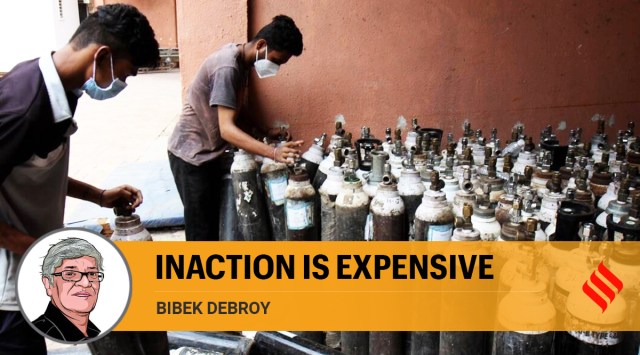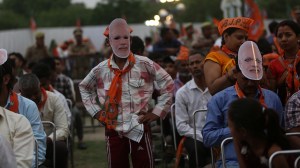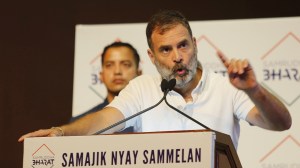- India
- International
Black marketing during the pandemic comes from longstanding, systemic flaws
Action not taken in the best of times now strikes back at us in the worst of times
 Oxygen cylinders at the Thane District Government Hospital (Express photo/Deepak Joshi)
Oxygen cylinders at the Thane District Government Hospital (Express photo/Deepak Joshi)Courts have passed strictures against hoarders and black marketeers. Across the country, there have been arrests for diversion, hoarding and black-marketing of remdesivir, oximeters and oxygen cylinders. These are emotive issues. A season of darkness brings out the worst among people. The spring of hope is that it also brings out the best and there are several instances of exceptional individuals and organisations who have done their bit to ensure the effects of the pandemic are mitigated. But there is also the example of fake remdesivir (and possibly azithromycin) produced in Kotdwar (Uttarakhand) and marketed in Delhi. The problem of fake and sub-standard drugs isn’t new. It’s been flagged several times. I recall a study done by Assocham about three years ago, estimating that one-third of drugs sold in India are fake. (A clear distinction isn’t always drawn between sub-standard and counterfeit, though they are distinct. That one-third figure is also a guess and the precise figure may be lower.) There are centres in and around Delhi (Bahadurgarh, Ghaziabad, Gurgaon, Faridabad, Noida, Sonepat) and Aligarh, Bhiwadi, Hisar and Agra. (Every Delhi resident knows of Bhagirath Palace.) Crocin, Voveran, Betadine or Cosavil may be fake or sub-standard. And this may also be true of a life-saving drug. It is difficult to quantify the morbidity and mortality effects of fake or sub-standard drugs, but they are substantial.
Legally, the Drugs and Cosmetics Act (DCA) has different categories of misbranded, adulterated and spurious drugs. De jure, this has plenty of teeth. Let me quote from the 2003 Mashelkar Committee. “The Committee noted that although the Drugs and Cosmetics Act has been in force for the past 56 years, the level of enforcement in many States has been far from satisfactory. The non-uniformity in the interpretation of the provisions of laws and their implementation and the varying levels of competence of the regulatory officials were the main reasons for this less than satisfactory performance… the problems in the regulatory system in the country were primarily due to inadequate or weak drug control infrastructure at the State and Central level… The Committee noted with dismay that most of the prosecution cases pertaining to offences related to spurious drugs remain undecided for years. There is no greater deterrent than a ‘severe’, ‘sure’ and ‘swift’ punishment.”
Post-Mashelkar Committee, let me quote from CDSCO (Central Drugs Standard Control Organisation). “Assistance has also been provided under the World Bank assisted Capacity Building Project to upgrade testing facilities and to establish new drug testing laboratories so as to enhance the capacity of laboratories to test large number of samples…. The Drugs & Cosmetics Act, 1940 has recently been amended by the Drugs & Cosmetics (Amendment) Act, 2008 for providing more stringent penalties to those involved in the trade of spurious drugs.”
Some offences have become non-bailable. There are specially designated courts and regulatory infrastructure has been strengthened. There is also a whistle-blower scheme. Has this improved matters? Probably, but pharmaceutical products shouldn’t be produced in the equivalent of garages and good manufacturing practices, and their enforcement, is a generic issue, not something we wake up to amid a pandemic. If governments purchase pharmaceutical products on L1 basis, it’s understandable that consumers should be price-sensitive, regardless of whether the drug is fake, sub-standard or expired. How many checks are there on chemists who sell without prescriptions and the nexus with doctors? Temporary outrage over fake RT-PCR test reports is misplaced, unless we decide to clamp down on everything fake.
We should also be careful about indiscriminately using terms like hoarder and black-marketeer. A hoarder is anyone who stocks up items. Expecting a lockdown, if I stock up on bottles of liquor, I am also a hoarder. So is a person who holds on to shares of a company, hoping for a better price. Of course, under excise laws, there is a limit on how many bottles of liquor can be held. In a similar vein, the crime isn’t hoarding per se but of selling a drug without a licence. Data on prosecutions, and convictions when prosecuted, of crimes under Drugs and Cosmetics Act, are an unhappy revelation. Incidentally, courts have ruled police officers can’t register FIRs, arrest and prosecute (for cognisable crimes) under this law. That’s the job of drugs inspectors.

The notion of a black market is different, though the two can be related. For instance, it can be a shadow market where one evades taxes. But in this context, it means charging a premium when there is a shortage. When there is a shortage, temporary or otherwise, prices will be higher than expected. This is no different from surge pricing used by cab companies, or ambulances charging exorbitant prices now. A black market occurs when the price at which a product is sold is higher than an administratively determined price. We are agitated at remdesivir selling for Rs 70,000 a vial because that price is significantly above MRP. Action not taken in the best of times now strikes back at us in the worst of times.
This column first appeared in the print edition on May 13, 2021 under the title ‘Inaction is expensive’. The writer is chairman, Economic Advisory Council to the Prime Minister. (Views are personal)
EXPRESS OPINION
Apr 24: Latest News
- 01
- 02
- 03
- 04
- 05










































